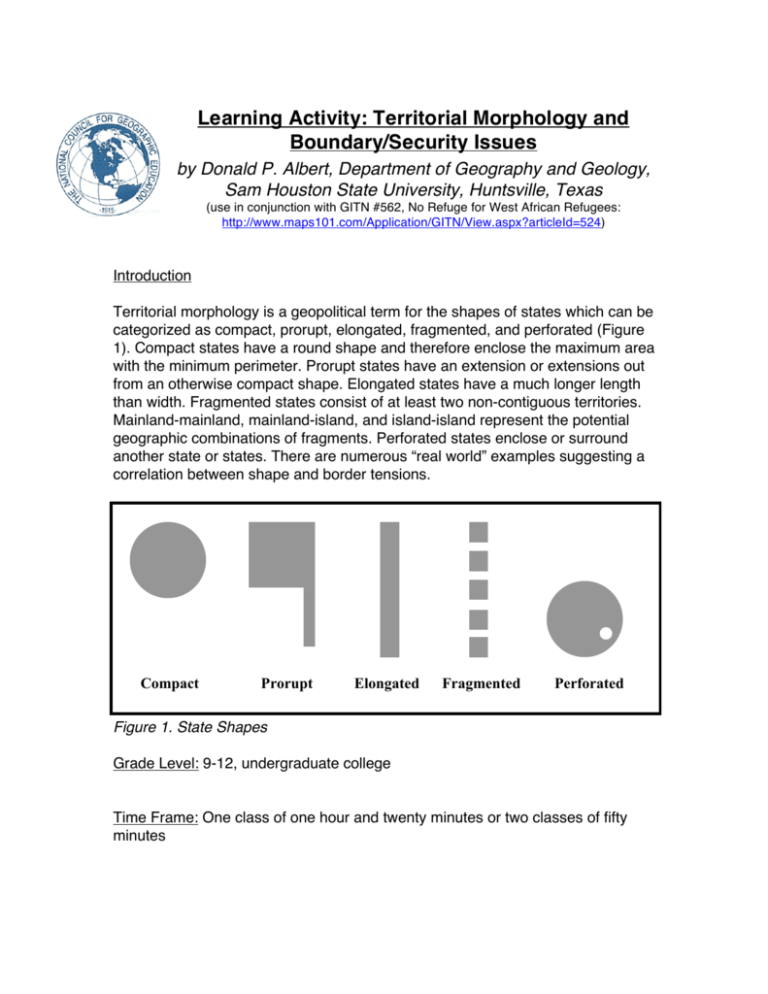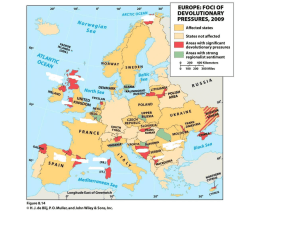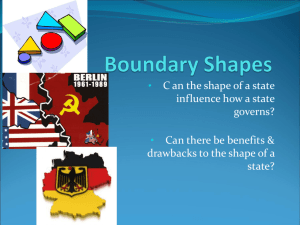Learning Activity: Territorial Morphology and Boundary
advertisement

Learning Activity: Territorial Morphology and Boundary/Security Issues by Donald P. Albert, Department of Geography and Geology, Sam Houston State University, Huntsville, Texas (use in conjunction with GITN #562, No Refuge for West African Refugees: http://www.maps101.com/Application/GITN/View.aspx?articleId=524) Introduction Territorial morphology is a geopolitical term for the shapes of states which can be categorized as compact, prorupt, elongated, fragmented, and perforated (Figure 1). Compact states have a round shape and therefore enclose the maximum area with the minimum perimeter. Prorupt states have an extension or extensions out from an otherwise compact shape. Elongated states have a much longer length than width. Fragmented states consist of at least two non-contiguous territories. Mainland-mainland, mainland-island, and island-island represent the potential geographic combinations of fragments. Perforated states enclose or surround another state or states. There are numerous “real world” examples suggesting a correlation between shape and border tensions. Compact Prorupt Elongated Fragmented Perforated Figure 1. State Shapes Grade Level: 9-12, undergraduate college Time Frame: One class of one hour and twenty minutes or two classes of fifty minutes Objectives The student will be able to: 1. name and define the basic state shapes associated with territorial morphology, 2. classify state boundary outlines in terms of compact, prorupt, elongated, fragmented, and/or perforated, and 3. recognize that some aspects of a stateʼs shape might exacerbate regional hostilities and conflict. Key Concepts • • • • • • • political geography territorial morphology compact prorupt elongated fragmented perforated National Geography Standards • Standard 13. How the forces of cooperation and conflict among people influence the division and control of earthʼs surface. Data Sources • • Reference Atlas http://www.maps101.com/Application/Catalog/Product.aspx?cid=126&pid=30 94 International Boundaries Research Unit, Mountjoy Research Centre, University of Durham, International Boundary News Database: http://www.dur.ac.uk/ibru/news/ Teacher Notes Central and Southern Africa present an excellent backdrop from which to discuss territorial morphology as all five state shapes exist within these regions! There are compact (Botswana, Zimbabwe), prorupt (Democratic Republic of the Congo, Namibia), elongated (Malawi), fragmented (Angola), and perforated (South Africa) state shapes. Because of their unusual shapes, Mozambique (ignoring small offshore islands) and Zambia resist classification; however, these countries share boundaries and, therefore, disputes with elongated and prorupt states respectively. Therefore, some state shapes, or the juxtaposition of similar or different state shapes, might produce a geopolitical arrangement that fosters border tensions. The International Boundary News Database is an excellent resource to locate news records that report on geopolitical events and issues. Students can submit a query, for example on Angola and the Democratic Republic of the Congo, and retrieve a set of boundary-related reports dating from 1991 to about six months before the current date. One can then scroll down the search results to peruse the entries. One might also use a “Find” command to locate particular place names within the search results. For example, use <Caprivi Strip> or <Cabinda> to find records associated with a proruption or fragmentation, respectively. Important place names within or adjacent to prorupt, fragmented, or perforated areas can be found using Reference Atlas. The following records from the International Boundary Database illustrate events and issues that have flared up along international borders. Compact – Zimbabwe CAPRIVI SEPARATISTS WARNED The government of Zimbabwe on 5 August reportedly issued a warning to Caprivi Strip separatists that it would not stand idly by while Namibia's territorial integrity was under threat. Zimbabwe has a mutual defense pact with Namibia, and the statement was issued in the wake of reports that the separatist 'Caprivi Liberation Army' also had designs on the Zimbabwean resort of Victoria Falls. 'THE NAMIBIAN', WINDHOEK, 5/8/99 Prorupt – Namibia NAMIBIA SETS UP BORDER POST ON ZAMBIA FRONTIER The Namibian government has set up a border post in the Caprivi Strip near Mambova to deter Zambian smugglers. The report of the new post was confirmed by the South Province immigration officer. BBC SWB ME/1232 15/11/91 Elongated – Malawi MALAWI - MOZAMBIQUE TRANSPORT CORRIDOR MEETING Mozambican President Joaquim Chissano met his Malwian counterpart, Bakili Muluzi in the port of Nacala on 22 June, to discuss Malawiʼs use of the Nacala Corridor. The main component of the corridor is the MalawiNacala railway, which is the shortest and cheapest route to the sea for Malawian exports. PANA NEWS AGENCY, INTERNET, 22/6/98 Fragmented – Angola ANGOLA - ZAIRE SEPARATISTS CLASH WITH ARMY Cabindan separatists claimed on 6 June that more than 150 people had been killed in clashes between their forces and government troops around the town of Necuto near the Zaire border since 10 May. Angolan forces were claimed to have attacked the town with tanks and helicopters, and the casualties were said to be mainly among the government forces and civilians. Both sides claimed to be in control of the town in the oil-rich Angolan enclave. SABC CHANNEL AFRICA, JOHANNESBURG, 6/6/96 Perforated – South Africa LESOTHO - SOUTH AFRICA "BORDER CRISIS" Talks between the Lesotho government and the South African ambassador on the border crisis have been held. The crisis is related to cattle rustling. Farmers in the former Transkei have been impounding stolen stock and blocking three mountain passes since Thursday. The talks also involve police and farmers although the farmers are still refusing to remove blockades. SWB AL/2135 SABC RADIO SOUTH AFRICA, 23/10/1994 Analysis of these and other records from the search results point out that certain state shapes or state-shape combinations might heighten border tensions. Cattle rustlers, smugglers, and separatists appear to operate with more vigor in or near fragments, proruptions, and perforations. Fragments with unequal distribution of resources (i.e., oil) spur internal conflict. Conflicts between a fragmented state and adjacent neighbors generate refugees. A perforated state might intimidate the state it surrounds with military exercises on their border. This exercise has been designed to illustrate possible connections between state shapes and border tensions. It is paramount to recognize, however, that state shapes are not deterministic, but do present a number of geopolitical challenges. Other Resources • • • • Barron, B. C., D. P. Albert, and J. Tiller. 2000. International shapes. The Social Studies Texan 16(2):56. Byklum, D. 1992. Continent X: The geopolitical lesson of size, shape, and location. Journal of Geography 91(1):18-22. De Blij, H. J. and P. O. Muller 2000. Regions 2000: Geography, Regions, and Concepts, 9th ed. New York: Wiley. Glassner, M. I. 1996. Political Geography, 2nd ed. New York: Wiley. Learning Activity Territorial Morphology and Boundary/Security Issues 1. Access the Reference Atlas (http://www.maps101.com/Application/Catalog/Product.aspx?cid=126&pid=30 94). Click on “Africa” to view/print a political map. 2. Indicate the most appropriate shape(s) that describes the countries listed in Table 1. More detailed (larger scale) maps are available by clicking on the countries in the Africa political map. State Shape(s) Angola Botswana Dem. Rep. of the Congo Malawi Mozambique Namibia Zambia Zimbabwe Table 1. State Shapes of Central and Southern Africa 3. Navigate to the International Boundary News Database (http://www.dur.ac.uk/ibru/news/). Retrieve database records using country names as search terms. For example, enter the search terms <Botswana Namibia>, check “Search Boundary Field only,” and “Submit Query.” The search results will include boundary-related news reports spanning the last decade. Run additional searches for all countries sharing international boundaries. Examine the search results for reports suggesting a possible linkage between a stateʼs shape and boundary and security issues. Focus on those news records that suggest a possible connection between proruptions, fragments, or perforations with border incidents. Cut and paste or otherwise highlight records that illustrate the point that specific state shapes often contribute to border tensions. Using this set of records, proceed to item 4. 4. List some factors where specific state shapes contributed to or exacerbated border tensions. Record results in Table 2. Shape Boundary/Security Issues Compact Protruded Elongated Fragmented Perforated Table 2. Shapes and Boundary and Security Issues First published April 2001.








